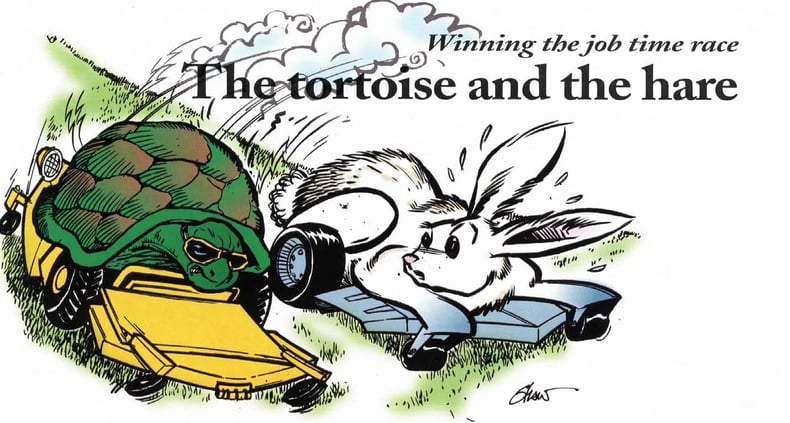We're all familiar with he story about the turtle and the rabbit. The rabbit has more speed, but the turtle has more determination, stamina and consistency. The rabbit may get a fast start, but the turtle wins the race.
When it comes to winning the job time race, the fastest mower - the mower with the fastest ground speed - is like the rabbit. It can mow fast, but it will often finish second to a machine that has more maneuverability and trimming capability, and the ability to overall manicure a lawn.
At Walker Mfg., we like to position the Walker Mower as the tortoise. No, it's not the fastest mower in the world (it's no slouch either), but when it comes to winning the job time race, it comes in first almost every time. Here's why.
The job time race begins and ends at the trailer, not at the edge of the mowed turf. One of the true measures of a mower's performance, including speed, is how long it takes a mowing crew to completely finish a job.
Let's position the rabbit (e.g., a compact mower with a belly-mounted deck) at the starting line. The mower tackles the straight-aways faster than the turtle (e.g., a Walker with a GHS deck). There's no question it is fast, but it can't take turns at 8 mph. If this 1,000-pound rabbit were to reverse direction at top speed, it's good-bye grass.
And having a mid-mounted deck, the rabbit can't trim close to hedges, trees, flower beds and other landscaping elements. In fact, built for speed and not maneuverability, the rabbit is far too clumsy for most trim work, leaving much of it to crew members with string line trin1mers.
Meanwhile, the turtle (a.k.a. Walker) is humming along at a near consistent speed. It's fast enough on the straight-aways and trimming - this turtle is built for turning. With its patented combination of Forward Speed Control and steering levers, only gentle fingertip pressure is needed to put the turtle through its paces. Forward and back, side to side, and forward and back again, the machine is like "poetry in motion."
Combine the outfront deck with the compact design of an integrated grass-handling system (GHS), and the turtle seems perfectly content to take a little extra time on the straightaways to quickly outmaneuver the hare on the turns.
Back at the race, the turtle's maneuverability has allowed it to close the gap on the rabbit. But just as it was gaining ground, its grass catcher needed emptying. Too bad, the rabbit wins by a nose. Or does it? At the finish line, the rabbit's operator picks up a trimmer to complete the trimming and then comes back for a blower to tidy up the walks, disperse clumps of grass and overall finish the job the rabbit only started. By now, the turtle is long gone, starting on its next job.
The moral of this story is simple: When it comes to mowing, speed is relative. A mower's overall speed should be measured by how long it takes to completely finish a job, not by how quickly it covers the ground. In fact, too much ground speed is a liability because it makes turning more difficult. And decks, even mid-mount decks, lose some of their efficiency at higher speeds.
The next time you see a rabbit mowing, admire its speed, but tip your hat to the turtle- the machine that's already heading to the next job.





 Site Search
Site Search



